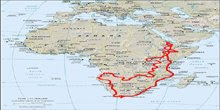After a few days in Nairobi - which we spent resting, doing laundry, fixing odds and ends on the car : changing the tyres, checking the bearing, disconnecting the immobiliser... - we will be leaving Nairobi tomorrow to carry on north to Ethiopia where we expect to spend between 4 and 6 weeks before returning to Nairobi. We got a three-month visa, here in Nairobi, for USD20 each.

The country is huge, the roads (we have heard) are slow going. We are keen to experience as much as we can of all its wonders.
Although Ethiopia was one of this journey’s main goals, it is also the place for which we knew the least about what to expect. Over the past few days we have been chatting to other travellers, and browsing through a few books, so now we have a slightly better idea of what is to come.
The country’s history is fascinating and its landscapes seem at times quite dramatic. What travellers tell us is that they have either loved or hated are the people. We are looking forward to live it for ourselves.
We have been told that internet connections are extremely slow and not really worth trying there, so don’t expect much news in the next month or two. We will try and update the blog again on our next visit to Nairobi.


















 Lunch spot by the Galana river
Lunch spot by the Galana river The Ugandan railway line on the edge of the Tsavo National Park : 147 of the workers who built it where eaten by 2 lions ("the man-eaters of Tsavo") at the beginning of the 20th century!
The Ugandan railway line on the edge of the Tsavo National Park : 147 of the workers who built it where eaten by 2 lions ("the man-eaters of Tsavo") at the beginning of the 20th century! The lioness finally taking a stroll... thus allowing Steve to get out of the car to fix the immobiliser
The lioness finally taking a stroll... thus allowing Steve to get out of the car to fix the immobiliser Red elephants
Red elephants  Rush hour in Tsavo National Park
Rush hour in Tsavo National Park
 The small but busy harbour at Mokowe
The small but busy harbour at Mokowe Lamu's main square
Lamu's main square  View of the main square from the fort
View of the main square from the fort  The fort's entrance
The fort's entrance
 Lamu's streets
Lamu's streets Shella beach
Shella beach Caro's new clothes - the bui-bui
Caro's new clothes - the bui-bui Tiwi beach
Tiwi beach  On Wahid's dhow, with Mike and Sarah
On Wahid's dhow, with Mike and Sarah

 Cut the veggies and coconut
Cut the veggies and coconut Twiga campsite
Twiga campsite Fry the onions, garlic and ginger in the cooking oil.
Fry the onions, garlic and ginger in the cooking oil. Immediately after; layer the prawns, coconut and pineapple. Do not stir, but leave as a layer on top.
Immediately after; layer the prawns, coconut and pineapple. Do not stir, but leave as a layer on top. 
 Watch the full moon rise over the palm trees.
Watch the full moon rise over the palm trees. It's ready !
It's ready !



.JPG) Les clous de girofle (cloves) poussent dans les arbres
Les clous de girofle (cloves) poussent dans les arbres  La racine de cette plante c’est le gingembre (ginger)
La racine de cette plante c’est le gingembre (ginger)  L’ecorce de cette arbre, si on la laisse secher au soleil, nous donne les batons de cannelle (cinnamon)
L’ecorce de cette arbre, si on la laisse secher au soleil, nous donne les batons de cannelle (cinnamon) Voila une noix de muscade (nutmeg)
Voila une noix de muscade (nutmeg)  Et voila comment poussent les ananas (pineapple)
Et voila comment poussent les ananas (pineapple) La vanille (vanilla), que vous connaissez surement, doit etre polinisee a la main car il n’y a pas de colibris (hummingbirds) sur Zanzibar
La vanille (vanilla), que vous connaissez surement, doit etre polinisee a la main car il n’y a pas de colibris (hummingbirds) sur Zanzibar Le poivre (pepper) est aussi une plante grimpante
Le poivre (pepper) est aussi une plante grimpante .JPG)
 La cardamone (cardamom) pousse au sol
La cardamone (cardamom) pousse au sol  Le cacao (cocoa) est un fruit…
Le cacao (cocoa) est un fruit…  Le henne un arbre…
Le henne un arbre…  Et la citronnelle (lemon grass) une herbe…
Et la citronnelle (lemon grass) une herbe…



